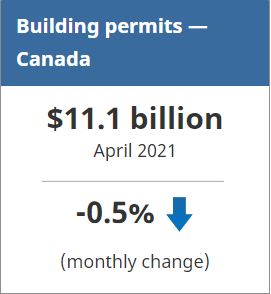Statistics Canada: Building Permits, April 2021
The total value of building permits remained at historically high levels in April 2021, edging down 0.5% to $11.1 billion, following the record set in March. The slight pullback was mainly due to declines in the residential sector in British Columbia and Quebec, which outweighed national gains in the non-residential sector.
On a constant dollar basis (2012=100), building permits were largely unchanged (-0.0%).
Residential sector remains strong despite decrease in April
In the residential sector, the value of building permits fell 6.7% to $7.7 billion in April. Despite the decrease, this was the second highest value on record. British Columbia (-23.7%) and Quebec (-14.9%) accounted for most of this decline.
The value of building permits for multi-family dwellings dropped 6.5% to $4.1 billion. Gains in Ontario and Alberta were not enough to offset decreases in British Columbia and Quebec, where several large permits had been issued (in both provinces) during the previous month.
Eight provinces reported a decline in the value of permits issued for single-family dwellings, with the national total down 7.0% to $3.6 billion, mainly as a result of fewer new projects in Ontario and Quebec.
Commercial and institutional components boost the non-residential sector
Commercial permits surged 28.7% to $1.9 billion in April. A $97 million permit for the Sick Kids patient support centre in the city of Toronto and an $80 million permit for the Centennial Community and Aquatics Centre in the city of New Westminster were among several large permits that were issued in the month. In contrast, the largest commercial permit issued nationwide in March was valued at $43 million and was for a warehouse in the city of Pickering.
The value of institutional permits increased 23.1% to $910 million, led by Quebec (+135.7%), which rebounded from a 53.6% drop the previous month. Quebec issued numerous large permits in April, such as for a new hospital in the city of Saint-Jean-Sur-Richelieu ($56 million) and for a new seniors’ care centre in the city of Belœil ($43 million).
The value of industrial permits fell 13.2% in April to $592 million. Ontario (-36.5%) accounted for most of the decrease, as fewer permits for large projects were issued in the province compared with the previous month.
Overall, the value of building permits in the non-residential sector climbed 17.4% to $3.4 billion.
To explore data using an interactive user interface, visit the Building permits: Interactive Dashboard.
To explore the impact of COVID-19 on the socioeconomic landscape, please consult the Canadian Economic Dashboard and COVID-19.
For more information on housing, please visit the Housing Statistics Portal.
Statistics Canada has a Housing Market Indicators dashboard. This Web application provides access to key housing market indicators for Canada, by province and by census metropolitan area. These indicators are updated automatically with new information from monthly releases, giving users access to the latest data.
To read the full report, click here.
Note to readers:
Unless otherwise stated, this release presents seasonally adjusted data with current dollar values, which facilitate month-to-month comparisons by removing the effects of seasonal variations. For information on seasonal adjustment, see Seasonally adjusted data – Frequently asked questions.
Starting with the March 2021 reference period, monthly constant dollar estimates have been made available for the entire data series (34-10-0066-01). Constant dollars remove the effects of price changes over time and are calculated using quarterly deflators from the Building Construction Price Index (18-10-0135-01). Typically, the first two months of a quarter use the previous quarter’s price level and are revised when the new quarterly price index becomes available.
Building components
– Single-family dwellings: Residential buildings containing only one dwelling unit (for example, single-detached house, bungalow, linked home [linked at the foundation]).
– Multi-family dwellings: Residential buildings containing multiple dwelling units (for example, apartment, apartment condominium, row house, semi-detached house).
– Industrial buildings: Buildings used in the processing or production of goods, or related to transportation and communication.
– Commercial buildings: Buildings used in the trade or distribution of goods and services.
– Institutional and government buildings: Buildings used to house public and semi-public services, such as those related to health and welfare, education, or public administration, as well as buildings used for religious services.
Revision
Unadjusted data for the current reference month are subject to revision based on late responses. Data for the previous month has been revised. Seasonally adjusted data for the previous two months have also been revised.
Trend-cycle estimates have been added to the charts as a complement to the seasonally adjusted series. Both seasonally adjusted data and trend-cycle estimates are subject to revision as additional observations become available. These revisions could be large and could even lead to a reversal of movement, especially at the end of the series. The higher variability associated with trend-cycle estimates is indicated with a dotted line on the chart.
For information on trend-cycle data, see the StatCan Blog and Trend-cycle estimates – Frequently asked questions.
Next release
Data on building permits for May will be released on July 2.
Source: Statistics Canada


